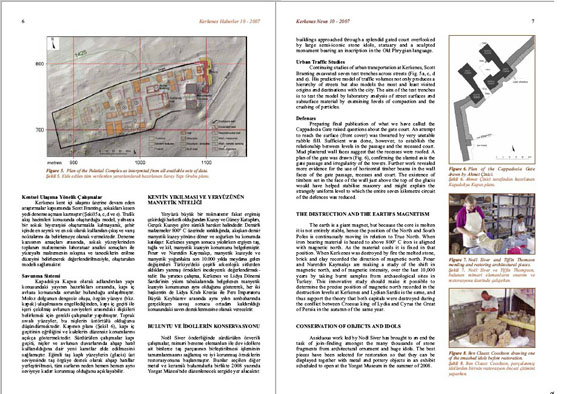Urban Traffic Studies
Continuing studies of urban transportation at Kerkenes, Scott Branting excavated seven test trenches across streets (Fig. 5a, c, d and e). His predictive model of traffic volumes not only produces a hierarchy of streets but also models the most and least visited origins and destinations with the city. The aim of the test trenches is to test the model by laboratory analysis of street surfaces and subsurface material by examining levels of compaction and the
crushing of particles.
Defences
Preparing final publication of what we have called the Cappadocia Gate raised questions about the gate court. An attempt to reach the surface (front cover) was thwarted by very unstable
rubble fill. Sufficient was done, however, to establish the relationship between levels in the passage and the recessed court. Mud plastered wall faces suggest that the recesses were roofed. A plan of the gate was drawn (Fig. 6), confirming the slanted axis the gate passage and irregularity of the towers. Further work revealed more evidence for the use of horizontal timber beams in the wall
faces of the gate passage, recesses and court. The existence of timbers set in the face of the wall just above the top of the glacis would have helped stabilise masonry and might explain the
strangely uniform level to which the entire seven kilometre circuit of the defences was reduced.
THE DESTRUCTION AND THE EARTH'S MAGNETISM
The earth is a giant magnet, but because the core is molten it is not entirely stable, hence the position of the North and South Poles is continuously moving in relation to True North. When
iron bearing material is heated to above 800° C iron is aligned with magnetic north. As the material cools it is fixed in that position. When Kerkenes was destroyed by fire the melted stone,
brick and clay recorded the direction of magnetic north. Pınar and Nuretdin Kaymakçı are making a study of the shift in magnetic north, and of magnetic intensity, over the last 10,000 years by taking burnt samples from archaeological sites in Turkey. This innovative study should make it possible to determine the precise position of magnetic north recorded in the destruction levels at Kerkenes and Lydian Sardis is the same, and thus support the theory that both capitals were destroyed during the conflict between Croesus king of Lydia and Cyrus the Great of Persia in the autumn of the same year.
CONSERVATION OF OBJECTS AND IDOLS
Assiduous work led by Noël Siver has brought to an end the task of join-finding amongst the many thousands of stone fragments from architectural ornament and huge idols. The best
pieces have been selected for restoration so that they can be displayed together with metal and pottery objects in an exhibit scheduled to open at the Yozgat Museum in the summer of 2008.
|



